Study on Load Transfer Mechanism of Pile-Supported Embankment Based on Response Surface Method
Abstract
:1. Introduction
2. Numerical Simulation of Pile-Supported Embankments
2.1. Model Establishment and Parameter Selection
2.2. Boundary Conditions and Mesh Division
2.3. Model Verification

3. Analysis of the Numerical Simulation Results
3.1. Single-Factor Test and Results Analysis
3.1.1. Cohesion
3.1.2. Internal Friction Angle
3.1.3. Elastic Modulus of Embankments
3.1.4. Geogrid Strength
3.1.5. Parameter Sensitivity Evaluation
3.2. Response Surface Optimization Test and Results Analysis
3.2.1. Response Surface Test Design
3.2.2. Analysis of the Interaction between Parameters
3.2.3. Validation of Response Surface Optimization Results
4. Conclusions
- (1)
- Using an elastic medium instead of a soft soil subgrade can reduce the calculation depth of the subgrade and improve the calculation efficiency of the model. The calculated values of the model were in good agreement with the measured results of the field test. The theoretical value of the model was calculated according to BS 8006-1 and the Nordic Geotechnical Group, and the change trend of the calculated value, as well as the theoretical value, were basically the same. This proved the rationality of this model.
- (2)
- Increasing the cohesion, the internal friction angle, and the elastic modulus of embankment filler can promote the soil arching effect to a certain extent. However, for reinforced embankments, larger cohesion, a larger internal friction angle, and a higher elastic modulus of the embankment will reduce the pile–soil differential settlement, affecting the load transfer and reducing the pile–soil stress ratio.
- (3)
- The increase in the geogrid strength had a certain promoting effect on the pile–soil stress ratio. However, when the geogrid strength reached 120 kN/m, the increase in the pile–soil stress ratio was small.
- (4)
- The pile–soil stress ratio was more sensitive to the changes of the internal friction angle of the embankment filler and the elastic modulus of the embankment, followed by the cohesion. The sensitivity of the geogrid strength was the lowest. Therefore, it is suggested that in the design of pile-supported embankments, in addition to the main design parameters, such as pile length, pile spacing, and grid strength., the influence of embankment filling properties on the load transfer should be considered.
- (5)
- The Box–Behnken design method was used for the experimental design, and the multiple regression model, considering the pile–soil stress ratio, was established. The variance analysis was used to test the fitting degree of the model. The results showed that the regression model can accurately reflect the change relationship between the influencing factors and response values, and that it is well-fitted to the actual situation.
- (6)
- The optimal parameter combination of the maximum pile–soil stress ratio was obtained by establishing a multiple regression equation. The numerical simulation results showed that the pile–soil stress ratio increased by 13.4%.
Author Contributions
Funding
Data Availability Statement
Conflicts of Interest
References
- Hewlett, W.J.; Randolph, M.F. Analysis of piled embankment. Ground Eng. 1988, 21, 12–18. [Google Scholar]
- BS 8006-1; 2010 Code of Practice for Strengthened/Reinforced Soils and Other Fills. British Standards Institution: London, UK, 2010.
- Zaeske, D.; Kempfert, H.G. Calculation and mechanism of unreinforced and reinforced base layers on point and line-shaped support members. Civ. Eng. 2002, 77, 80–86. [Google Scholar]
- Yun-Min, C.; Ning, J.I.A.; Ren-Peng, C. Soil arch analysis of pile-supported embankment. China J. Highw. Transp. 2004, 17, 4–9. [Google Scholar]
- Carlsson, B. Reinforced Soil, Principles for Calculation; Terratema AB: Linöping, Sweden, 1987. [Google Scholar]
- Nordic Geotechnical Group. Nordic Guidelines for Reinforced Soils and Fills; Nordic Geotechnical Group: Stockholm, Sweden, 2004. [Google Scholar]
- Van Eekelen, S.J.M.; Bezuijen, A.; Van Tol, A.F. An analytical model for arching in piled embankments. Geotext. Geomembr. 2013, 39, 78–102. [Google Scholar] [CrossRef]
- Jones, C.J.F.P.; Lawson, C.R.; Ayres, D.J. Geotextile reinforced piled embankments. In Proceedings of the 4th International Conference on Geotextiles: Geomembranes and Related Products, Rotterdam, The Netherlands, 28 May–1 June 1990; A. A. Balkema: Rotterdam, The Netherlands, 1992; pp. 155–160. [Google Scholar]
- Low, B.K.; Tang, S.K.; Choa, V. Arching in piled embankments. J. Geotech. Eng. 1994, 120, 1917–1938. [Google Scholar] [CrossRef]
- Rogbeck, Y.; Gusta Vsson, S.; Sodergren, I. Reinforced piled embankments in Sweden-design aspects. In Proceedings of the 1998 Sixth International Conference on Geosynthetics, Atlanta, GA, USA, 25–29 March 1998; pp. 755–762. [Google Scholar]
- Bo, L.I.; Mao-Song, H.; Guan-Bao, Y.E. Analysis of Three-dimensional Soil Arching Effect of Pile-supported Embankment with Geosynthetics and Its Test Verification. China J. Highw. Transp. 2012, 25, 13–20. [Google Scholar]
- Chao, X.U.; Xiao, L.; Pan-Pan, S. Model tests of tensile membrane effect of geosynthetic-reinforced Piled embankments. Rock Soil Mech. 2016, 37, 182–1831. [Google Scholar]
- Chen, F.Q.; Li, A. Improved design method of geosynthetic reinforced pile supported embankments on soft soil. Chin. J. Geotech. Eng. 2007, 29, 1804–1808. [Google Scholar]
- Hu, S.; Zhuang, Y.; Zhang, X.; Dong, X. A Design Chart for the Analysis of the Maximum Strain of Reinforcement in GRPEs Considering the Arching and Stress History of the Subsoil. Appl. Sci. 2022, 12, 2536. [Google Scholar] [CrossRef]
- Rui, R.; Yi, W.; Cheng, C.; Yan, Z.; Kai, Z. Experimental Investigation on Influences of Geosynthetic Reinforcement on Deformation Pattern and Soil Arching in Piled Embankments. China J. Highw. Transp. 2020, 33, 40–50. [Google Scholar]
- Bao, N.; Wei, J.; Chen, J.-F. Three dimensional discrete element analysis of soil arching in piled embankment. Rock Soil Mech. 2020, 41 (Suppl. S1), 347–354. [Google Scholar]
- Bao, N.; Wei, J.; Chen, J.F.; Wei, P. 2D and 3D discrete numerical modelling of soil arching. J. Zhejiang Univ.-Sci. A (Appl. Phys. Eng.) 2020, 21, 350–365. [Google Scholar] [CrossRef]
- Lai, H.J.; Zheng, J.J.; Zhang, R.J.; Cui, M.J. Visualization of the formation and features of soil arching within a piled embankment by discrete element method simulation. J. Zhejiang Univ.-SCIENCE A (Appl. Phys. Eng.) 2016, 17, 803–817. [Google Scholar] [CrossRef] [Green Version]
- Lai, H.J.; Zheng, J.J.; Zhang, J.; Zhang, R.J.; Cui, L. DEM analysis of “soil”-arching within geogrid-reinforced and unreinforced pile-supported embankments. Comput. Geotech. 2014, 61, 13–23. [Google Scholar] [CrossRef]
- Xu, C.; Song, S. Scaled Modle Tests of Soil Arching Effect in Geosynthetic Reinforced and Pile Supported Embankments. Chin. J. Rock Mech. Eng. 2015, 34, 4343–4350. [Google Scholar]
- Cao, W.; Chen, R.P.; Chen, Y.M. Experimental investigation on soil arching in piled reinforced embankments. Chin. J. Geotech. Eng. 2007, 29, 436–441. [Google Scholar]
- Yun-Min, C.; Wei-Ping, C.; Ren-Peng, C. An experimental investigation of soil arching within basal reinforced and unreinforced piled embankments. Geotext. Geomembr. 2008, 26, 164–174. [Google Scholar] [CrossRef]
- Liu, H.L.; Ng, C.W.; Fei, K. Performance of a geogrid-reinforced and pile-supported highway embankment over soft clay: Case study. J. Geotech. Geoenviron. Eng. 2007, 133, 1483–1493. [Google Scholar] [CrossRef]
- Wachman, G.S.; Biolzi, L.; Labuz, J.F. Structural Behavior of a pile-supported embankment. J. Geotech. Geoenviron. Eng. 2010, 136, 26–34. [Google Scholar] [CrossRef]
- Briançon, L.; Simon, B. Performance of pile-supported Embankment over soft soil: Full-scale experiment. J. Geotech. Geoenviron. Eng. 2012, 138, 551–561. [Google Scholar] [CrossRef]
- Zhuang, Y.; Ellis, E. Finite-element analysis of a piled embankment with reinforcement compared with BS 8006 predictions. Geotechnique 2014, 64, 910–917. [Google Scholar] [CrossRef]
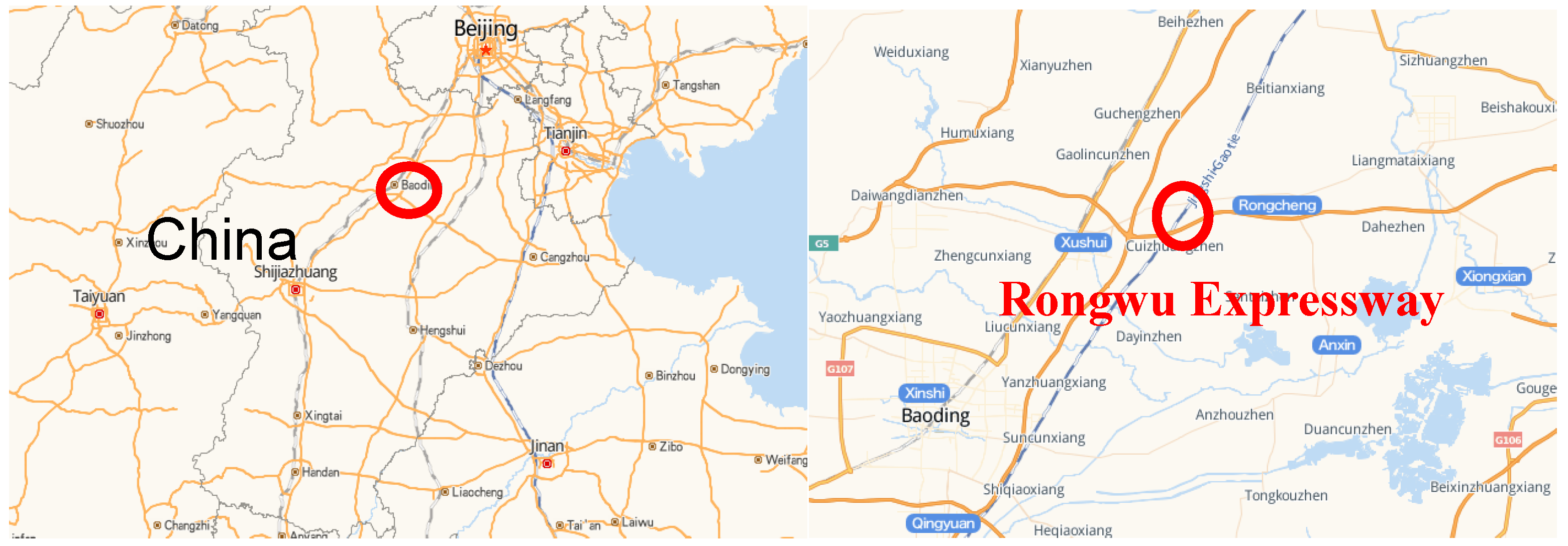

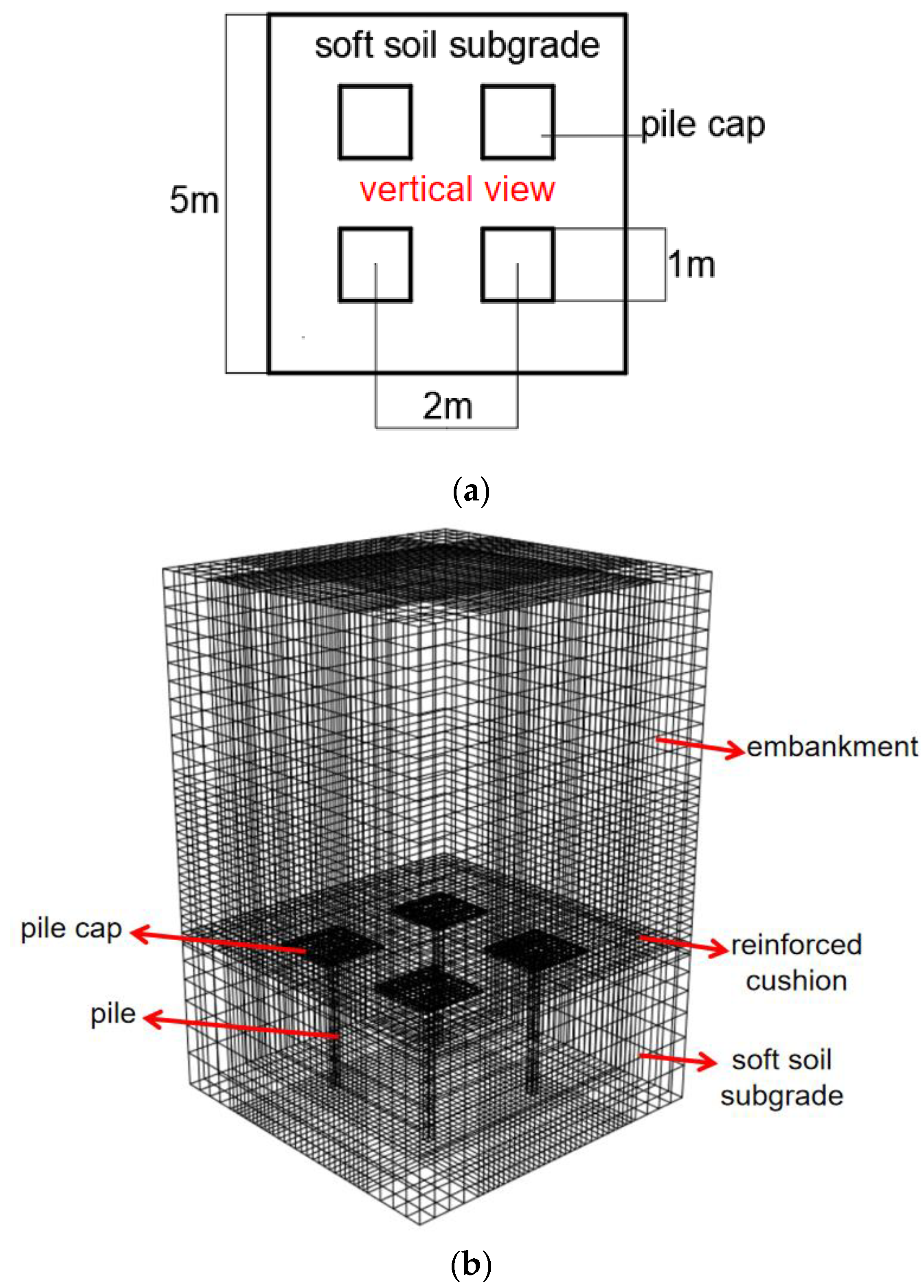

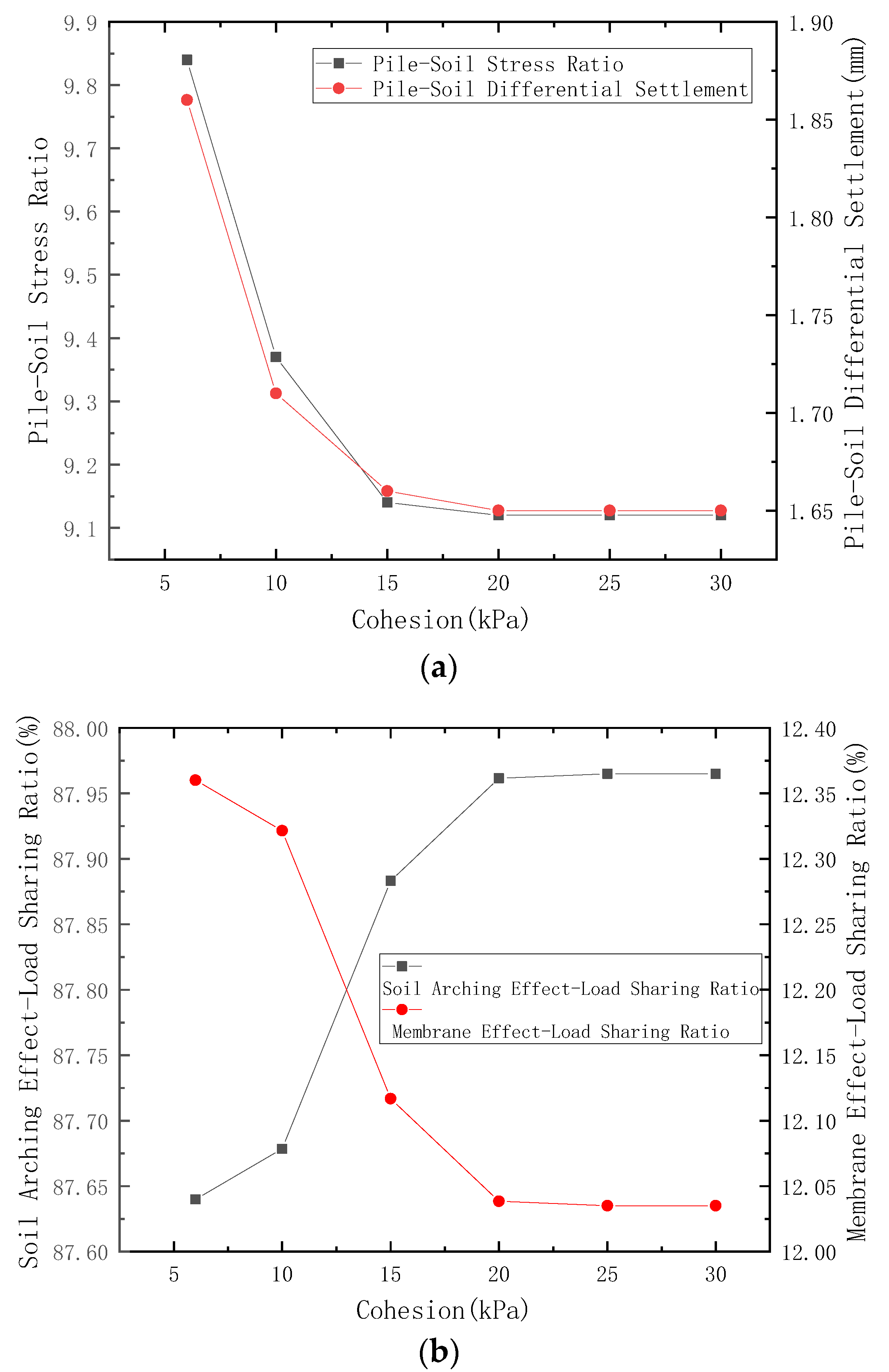
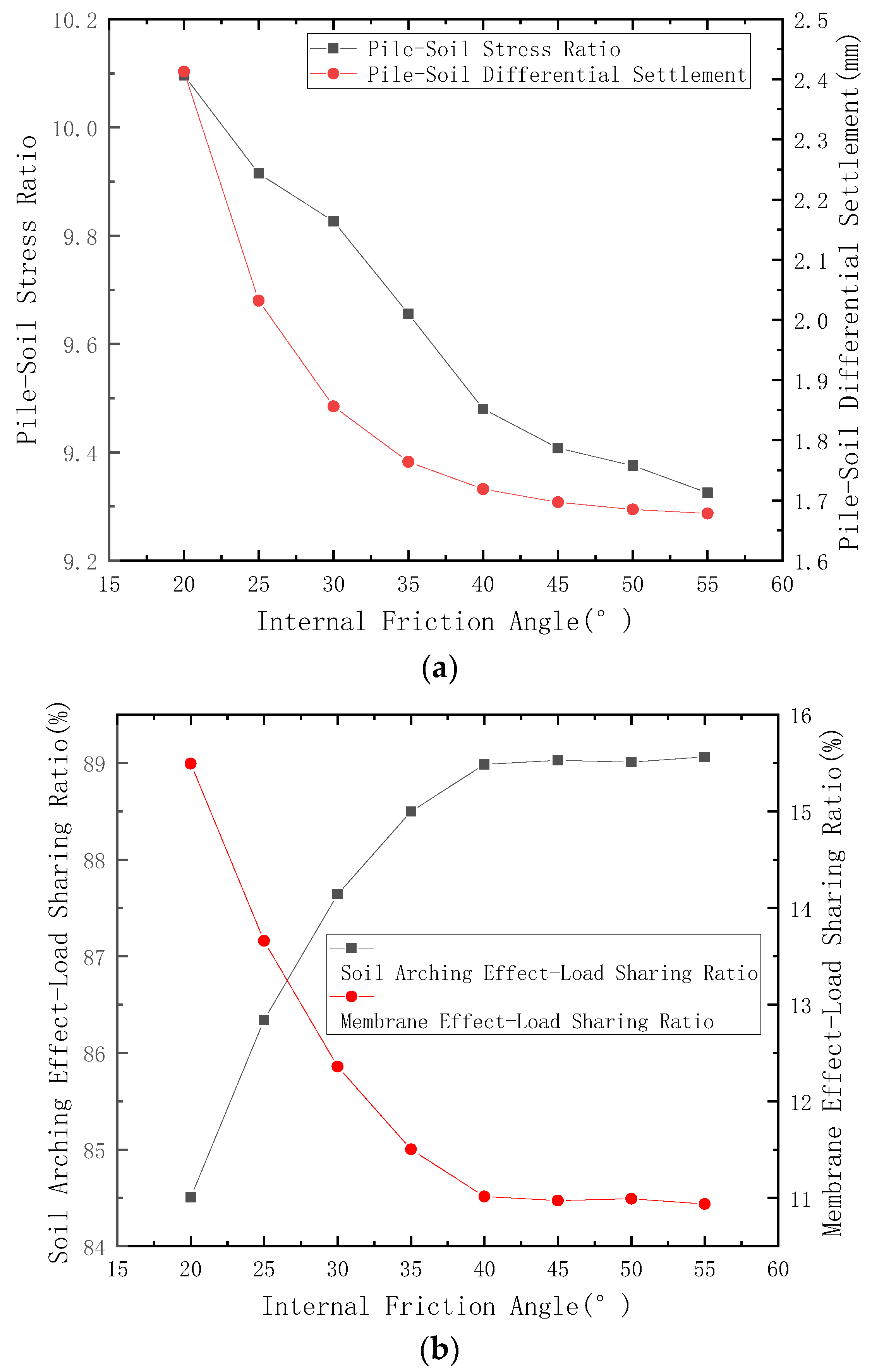


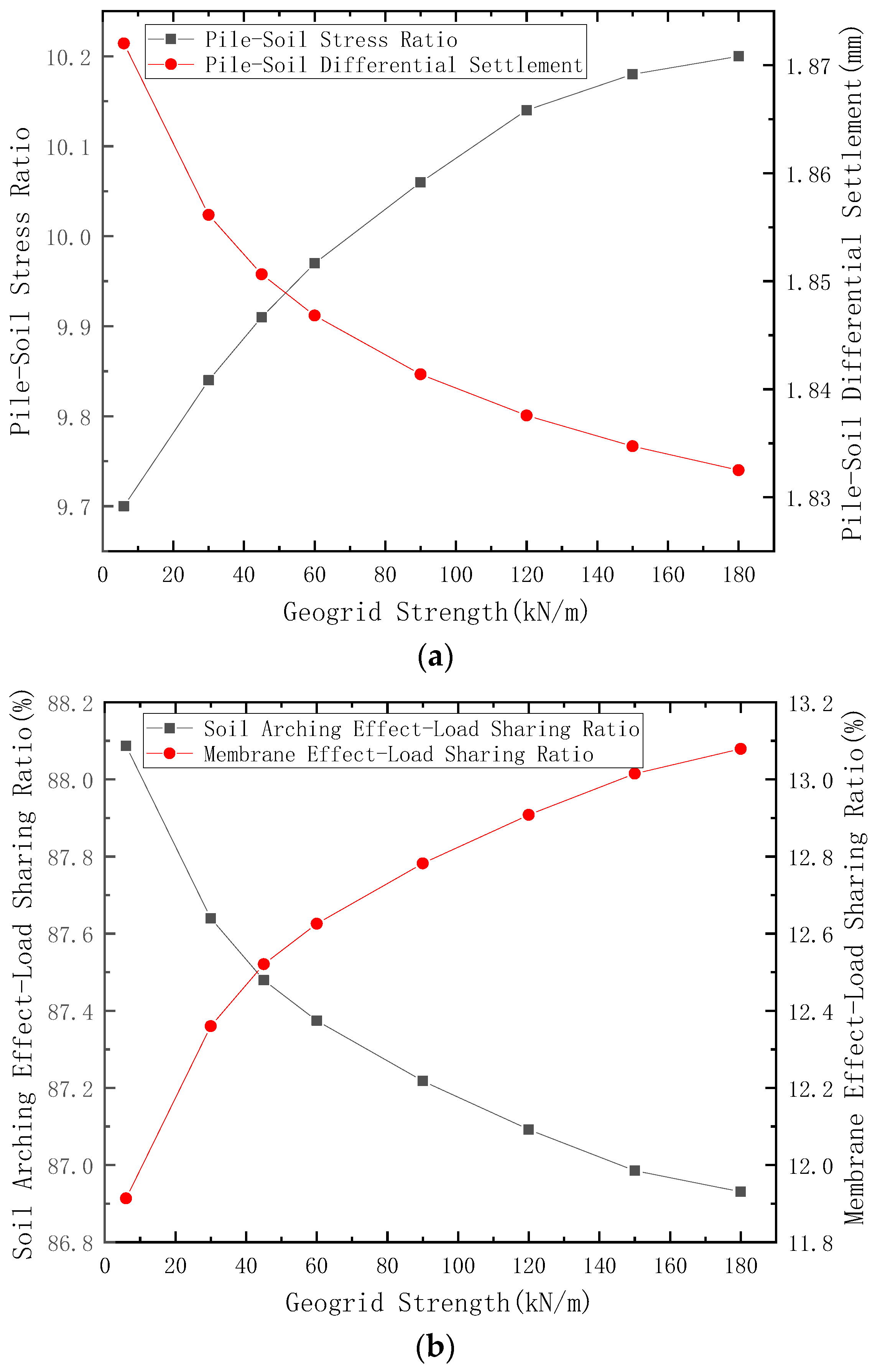
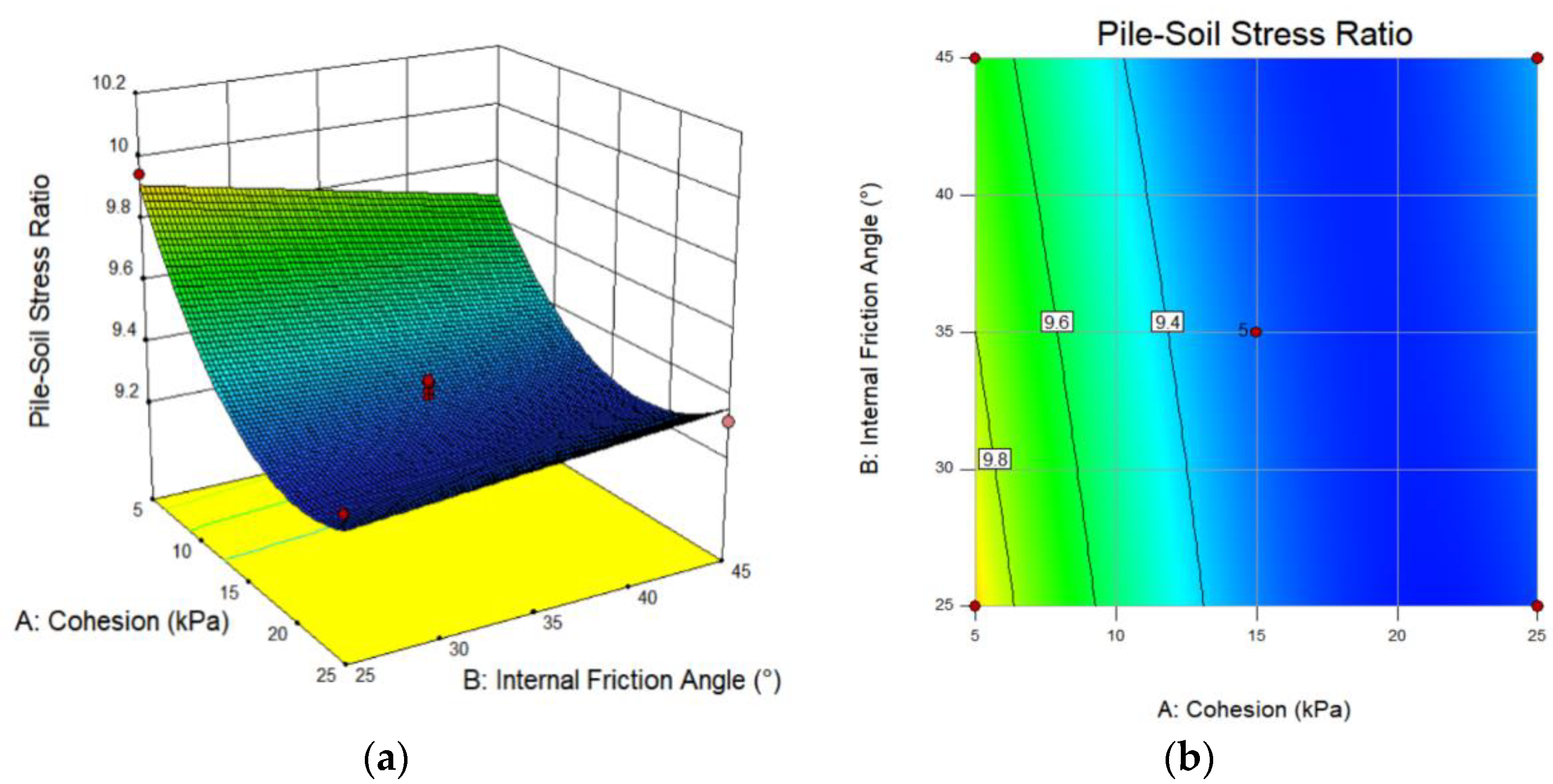
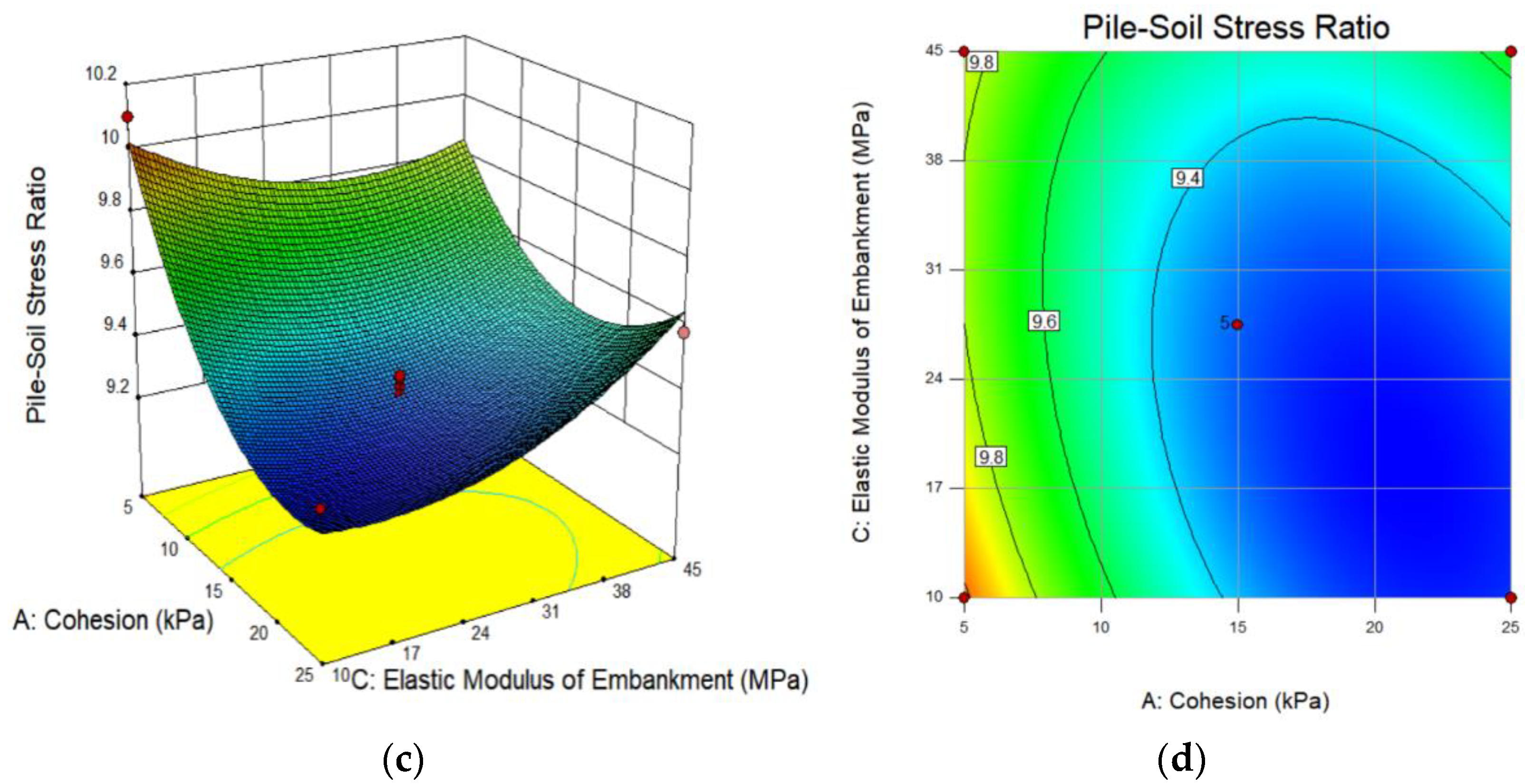

| Material | Thickness (Length) [m] | Volume Weight [kN/m3] | E [MPa] | Poisson Ratio | Internal Friction Angle [°] | Cohesion [kPa] |
|---|---|---|---|---|---|---|
| Pile | 2 | 25 | 20,000 | 0.2 | - | - |
| Geogrid | - | - | 0.5 | 0.2 | - | - |
| Cushion | 0.3 | 20 | 20 | 0.3 | 37 | 6 |
| Embankment | 5 | 18.5 | 15 | 0.35 | 30 | 6 |
| Soft soil subgrade | 2 | 0.25 | 4 | 0.34 | - | - |
| NO. | Cohesion [kPa] | Angle of Internal Friction [°] | Elastic Modulus of Embankment [MPa] | Geogrid Strength [kN/m] | Declaration |
|---|---|---|---|---|---|
| 1 | 6 | 30 | 15 | 30 | Model validation |
| 2 | 10 | 30 | 15 | 30 | Models 1–6 analyze the effect of cohesion |
| 3 | 15 | 30 | 15 | 30 | |
| 4 | 20 | 30 | 15 | 30 | |
| 5 | 25 | 30 | 15 | 30 | |
| 6 | 30 | 30 | 15 | 30 | |
| 7 | 6 | 20 | 15 | 30 | Model 1 and models 7–13 analyze the effect of internal friction angle |
| 8 | 6 | 25 | 15 | 30 | |
| 9 | 6 | 35 | 15 | 30 | |
| 10 | 6 | 40 | 15 | 30 | |
| 11 | 6 | 45 | 15 | 30 | |
| 12 | 6 | 50 | 15 | 30 | |
| 13 | 6 | 55 | 15 | 30 | |
| 14 | 6 | 30 | 10 | 30 | Model 1 and models 14–21 analyze the effect of embankment elastic modulus |
| 15 | 6 | 30 | 20 | 30 | |
| 16 | 6 | 30 | 25 | 30 | |
| 17 | 6 | 30 | 30 | 30 | |
| 18 | 6 | 30 | 35 | 30 | |
| 19 | 6 | 30 | 45 | 30 | |
| 20 | 6 | 30 | 55 | 30 | |
| 21 | 6 | 30 | 65 | 30 | |
| 22 | 6 | 30 | 15 | 6 | Model 1 and models 22–28 analyze the effect of geogrid strength |
| 23 | 6 | 30 | 15 | 45 | |
| 24 | 6 | 30 | 15 | 60 | |
| 25 | 6 | 30 | 15 | 90 | |
| 26 | 6 | 30 | 15 | 120 | |
| 27 | 6 | 30 | 15 | 150 | |
| 28 | 6 | 30 | 15 | 180 |
| Influencing Factor | Evaluation Scope | Sensitivity Coefficient |SAF| |
|---|---|---|
| Cohesion [kPa] | 6–25 | 0.175 |
| Internal Friction Angle [°] | 25–45 | 0.253 |
| Elastic Modulus of Embankment [MPa] | 10–45 | 0.24 |
| Geogrid Strength [kN/m] | 30–120 | 0.048 |
| Influencing Factors | Coding Level | ||
|---|---|---|---|
| −1 | 0 | 1 | |
| Cohesion A [kPa] | 2 | 15 | 27 |
| Internal Friction Angle B [°] | 25 | 35 | 45 |
| Elastic Modulus of Embankment C [MPa] | 10 | 27.5 | 45 |
| Geogrid Strength D [kN/m] | 30 | 75 | 120 |
| NO. | Cohesion A [kPa] | Internal Friction Angle B [°] | Elastic Modulus of Embankment C [MPa] | Geogrid Strength D [kN/m] | Pile–Soil Stress Ratio n |
|---|---|---|---|---|---|
| 1 | −1 | −1 | 0 | 0 | 9.95 |
| 2 | 1 | −1 | 0 | 0 | 9.32 |
| 3 | −1 | 1 | 0 | 0 | 9.63 |
| 4 | 1 | 1 | 0 | 0 | 9.32 |
| 5 | 0 | 0 | −1 | −1 | 9.21 |
| 6 | 0 | 0 | 1 | −1 | 9.43 |
| 7 | 0 | 0 | −1 | 1 | 9.43 |
| 8 | 0 | 0 | 1 | 1 | 9.61 |
| 9 | −1 | 0 | 0 | −1 | 9.66 |
| 10 | 1 | 0 | 0 | −1 | 9.21 |
| 11 | −1 | 0 | 0 | 1 | 9.94 |
| 12 | 1 | 0 | 0 | 1 | 9.40 |
| 13 | 0 | −1 | −1 | 0 | 9.39 |
| 14 | 0 | 1 | −1 | 0 | 9.33 |
| 15 | 0 | −1 | 1 | 0 | 9.51 |
| 16 | 0 | 1 | 1 | 0 | 9.52 |
| 17 | −1 | 0 | −1 | 0 | 10.10 |
| 18 | 1 | 0 | −1 | 0 | 9.32 |
| 19 | −1 | 0 | 1 | 0 | 9.80 |
| 20 | 1 | 0 | 1 | 0 | 9.58 |
| 21 | 0 | −1 | 0 | −1 | 9.22 |
| 22 | 0 | 1 | 0 | −1 | 9.21 |
| 23 | 0 | −1 | 0 | 1 | 9.33 |
| 24 | 0 | 1 | 0 | 1 | 9.32 |
| 25 | 0 | 0 | 0 | 0 | 9.32 |
| 26 | 0 | 0 | 0 | 0 | 9.30 |
| 27 | 0 | 0 | 0 | 0 | 9.35 |
| 28 | 0 | 0 | 0 | 0 | 9.29 |
| 29 | 0 | 0 | 0 | 0 | 9.36 |
| Type | Sum of Squares | Degree of Freedom | Mean Square | F Value | Prob(P) > F |
|---|---|---|---|---|---|
| Model | 1.496 | 8 | 0.187 | 58.475 | <0.0001 |
| Cohesion A | 0.715 | 1 | 0.715 | 223.468 | <0.0001 |
| Internal Friction Angle B | 0.013 | 1 | 0.013 | 3.999 | 0.0593 |
| Elastic Modulus of Embankment C | 0.038 | 1 | 0.038 | 11.814 | 0.0026 |
| Geogrid Strength D | 0.095 | 1 | 0.095 | 29.687 | <0.0001 |
| AB | 0.025 | 1 | 0.025 | 7.681 | 0.0118 |
| AC | 0.078 | 1 | 0.078 | 24.270 | <0.0001 |
| A2 | 0.463 | 1 | 0.463 | 144.622 | <0.0001 |
| C2 | 0.128 | 1 | 0.128 | 39.990 | <0.0001 |
| Residual | 0.064 | 20 | 0.003 | ||
| Pure Error | 0.004 | 4 | 0.001 | ||
| Lack of Fit | 0.060 | 16 | 0.004 | 4.072 | 0.092 |
| Cor Total | 1.560 | 28 | |||
| R2= 0.943 CV = 0.598 Adeq precision = 26.784 | |||||
| Cohesion [kPa] | Internal Friction Angle [°] | Elastic Modulus of Embankment [MPa] | Geogrid Strength [kN/m] | Pile–Soil Stress Ratio n | |
|---|---|---|---|---|---|
| Original Embankment Design | 6 | 30 | 15 | 30 | 9.7 |
| Predict the Optimal Combination | 5 | 25.076 | 10 | 117.749 | 10.3 |
| Optimization Model Verification | 5 | 25 | 10 | 120 | 11 |
Publisher’s Note: MDPI stays neutral with regard to jurisdictional claims in published maps and institutional affiliations. |
© 2022 by the authors. Licensee MDPI, Basel, Switzerland. This article is an open access article distributed under the terms and conditions of the Creative Commons Attribution (CC BY) license (https://creativecommons.org/licenses/by/4.0/).
Share and Cite
Wang, X.; Wang, X.; Yang, G.; Zong, Y. Study on Load Transfer Mechanism of Pile-Supported Embankment Based on Response Surface Method. Appl. Sci. 2022, 12, 4905. https://doi.org/10.3390/app12104905
Wang X, Wang X, Yang G, Zong Y. Study on Load Transfer Mechanism of Pile-Supported Embankment Based on Response Surface Method. Applied Sciences. 2022; 12(10):4905. https://doi.org/10.3390/app12104905
Chicago/Turabian StyleWang, Xin, Xizhao Wang, Guangqing Yang, and Yiming Zong. 2022. "Study on Load Transfer Mechanism of Pile-Supported Embankment Based on Response Surface Method" Applied Sciences 12, no. 10: 4905. https://doi.org/10.3390/app12104905





